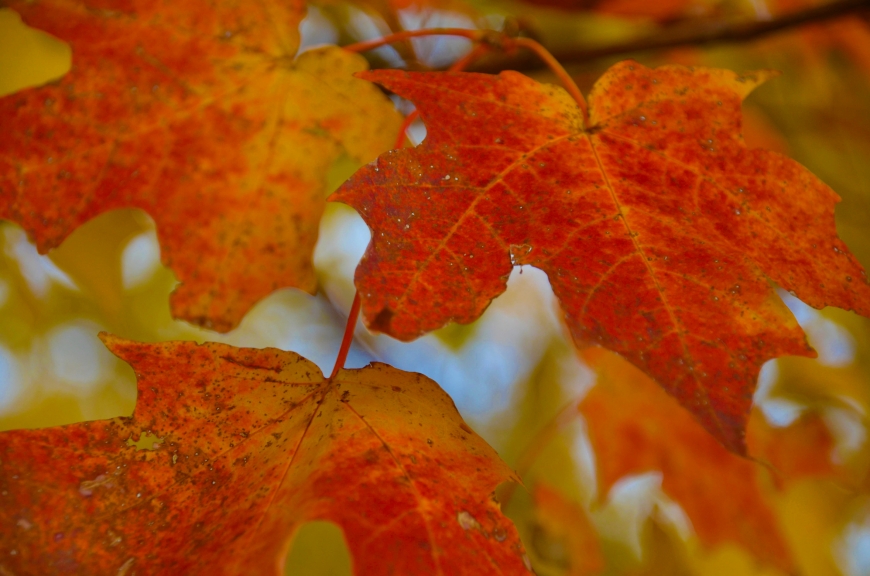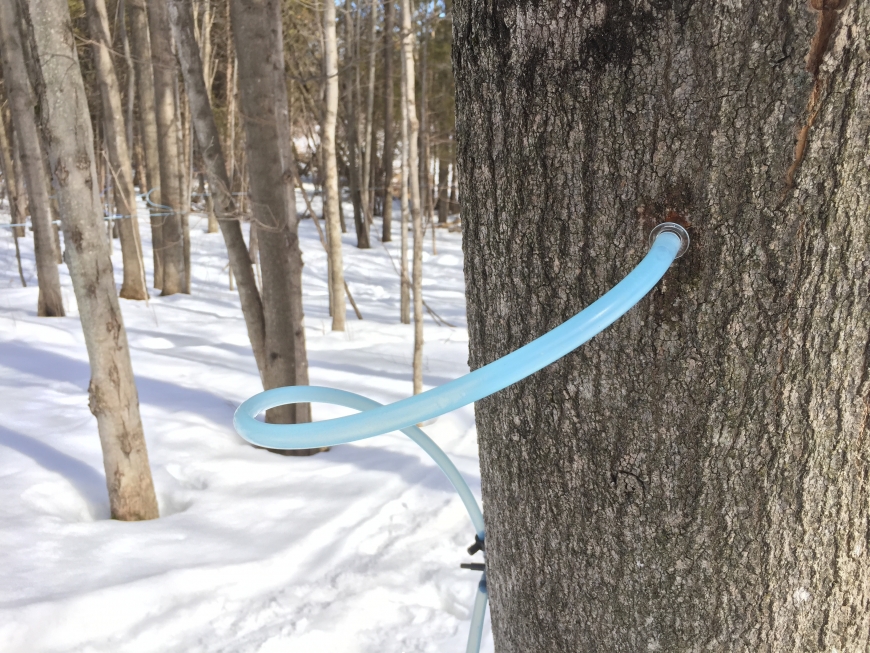

Sugar maple leaves in their fall glory. Photo: David Pynchon
Declining maple growth could have profound impacts on the maple syrup industry.


Maples in Peril
Remember that kid at school who was good at everything? Smart, athletic, popular, usually in a higher income bracket—seems like there was one in every class who must have taken more than their fair share when luck was handed out. And didn’t you find them annoying some days?
I imagine that’s how the rest of the forest community feels about sugar maple, Acer saccharum. Also known as hard maple, this icon of the Northeast has worn out more camera shutters than any other tree. Whether it’s their stunning fall foliage, the welcome summer shade they provide, or the stately sense of grandeur a line of them brings to back roads, our native sugar maple stands apart.
In terms of firewood, sugar maple is the gold standard in northern New York, and is prized for the gorgeous furniture and flooring it can become. Then there’s its sweetness. Never mind that maple production is important to our regional economy, pass the syrup already, my pancakes are getting cold!
No one knows how far back the tradition of sugaring goes. But the Haudenosaune (Iroquois), who taught the settlers how to make syrup and sugar from maples, still hold the tree in high esteem, and observe the Maple Thanksgiving every year to express gratitude for yet one more gift from the Creator.
In back yards across the North Country every spring, barbeques and homemade wood stoves are fired up to boil maple sap. Who cares if it takes an entire tank of propane to make a pint of syrup, the point is that you made it. Commercial producers are already setting out lines in preparation for spring sap flow.
Wouldn’t you feel a bit jealous of sugar maple if you were an ironwood or poplar? I have my suspicions. I think the rest of the forest should give maple some slack, though, given its health problems. Sadly, our maples are not doing as well as they seem.
In October 2015, the alarming results of a new study looking at forty years of maple growth rings in northern NY were released by SUNY-ESF in Syracuse. I’ll let one of the study’s co-authors, Dr. Neil Pederson, an ecologist at Harvard Forest in Massachusetts and an expert on tree rings and climate change, speak for himself:
“Outside of studies of red spruce in the 1970s, I have never seen anything quite like this. Most tree-ring studies of canopy trees in the region do not show a decline like what we see in these sugar maple. Combined with evidence of reduced natural regeneration of sugar maple in the region, it is a concern.”
Given the parade of significant tree-stress events in recent years, this does not bode well for maples. Over the past 30 years we’ve had more frequent droughts, including the unprecedented (in terms of soil moisture) one in 2012. According to Plant Pathologist Dr. George Hudler of Cornell University, it takes a tree two to three years to recover from even a moderate drought. And it may take a decade to recover from events like the 1998 ice storm. Less-visible (and therefore lesser known) issues like infestations of European fruit lecanium scales take a toll as well.
As if that wasn’t bad enough, maples now face new threats from invasive species never before seen in North America such as the spotted lanternfly from China which arrived in late 2014. Asian jumping worms sound like a joke, but they could single-handedly (handedly in a figurative sense) lead to the demise of forest ecosystems, including your sugar bush, if they get unknowingly tracked around on equipment or even shoe treads.
Anyone concerned about maple health, especially backyard syrup makers and commercial producers, can learn a lot more about the threats facing the sugar maple, and what to do about them, by attending this year’s Maple Expo at Gouverneur High School on Saturday, January 30 from 8AM to 3PM. Other topics include kinder, gentler ways of tapping, how to increase sap yield without using vacuum pumps, marketing and more. For more information, please call Cornell Cooperative Extension at (315) 379-9192.

